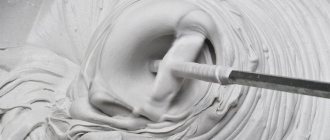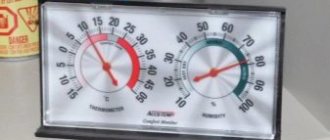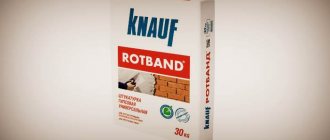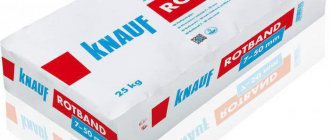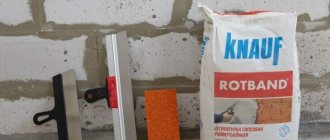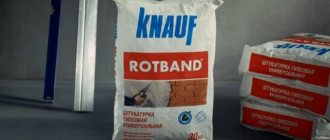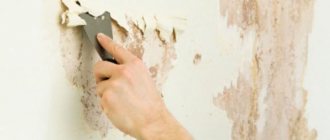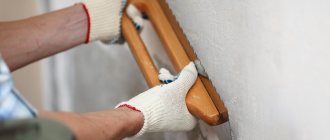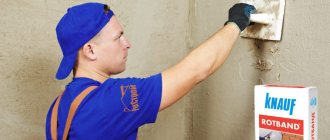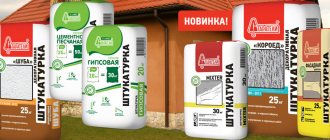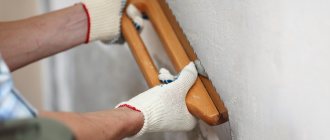We bring to your attention our brief review, which we hope will help you in choosing Prospector or Rotband plaster from the Knauf company. Comparison and recommendations will be based on three points:
- Objective indicators from official sources;
- Consumer reviews;
- Our subjective opinion;
Can plaster be mixed by hand?
If you don’t have a special tool at hand, you can spread the putty manually
. This method is applicable for preparing a starting coating, which is not particularly demanding on the mixing method. For this, use an ordinary bucket or other container without rounded corners.
Interesting materials:
How to line the inside of a bathhouse with clapboard? How to cover OSB walls correctly? How to properly sheathe an iron door? How to wear the L1 suit correctly? How to wear a combined arms protective kit correctly? How to wear a duvet cover correctly? How to properly plaster a ceiling? How to fatten pigs correctly? How to steam clothes with an iron? How to properly saw off the baseboard in the corners?
Analogous to Rotband.
So, the crisis is in full swing. The flow of oil rubles has decreased sharply. In the direction of construction and renovation, only a small part of what was a year or two ago is now allocated. Therefore, people began to save on repairs. First of all, the wave of savings affected the demand for finishing building materials. Why was the notorious “Rotband” so popular among domestic developers? The first is the brand. If the master said: “I will work with Rotband,” this meant that we were talking about gypsum plaster for interior work. Similarly: “I’ll level it with Vetonit,” which means there’s work to be done on finishing putty. Or: “They laid it on “Eunice” in the kitchen - they just mention the tile work. Well, honor and praise to such manufacturers, whose brand names have become associations with gypsum plaster, finishing putty, and tile adhesive. But the brand costs money. The second is reliability and virtually no defects. Third, kickbacks and dealer relationships. When there is a lot of money, you can overpay. But when you feel sorry for your dear ones, who already don’t have enough for cheese and sausage, you involuntarily think: “Why, exactly?” And really, why? Well, what is so magical about the composition of gypsum plaster produced by Tigi-Knauf? After all, many manufacturers produce it. Here are “Volma”, and the same “Yunis”, and “Prospectors”, and “Bolars”, and “Perfecta”, and “Pobedit”, and “Pro”, and even the reviving “Ivsil” with “Farvest”. Are all these plasters really so much worse than Rotband that you have to pay 20-40% more? What's the matter here? The point lies, first of all, in the habits of the repairmen whom you invited to your home. If they are used to Rotband” - it is difficult to convince them, they are “hooked” on “Yunis Teplon” - and do not want to hear anything else, they tried “Volma” - and will not turn them off the straight path along which Allah is leading them. But it’s the owner who has to “order the music”; his money will be spent on the purchase, some of which the same “Rotband” pumps into advertising. But the workers scare the owner: “If something goes wrong, they will say, well, they say, we said so…”. What could be wrong? Gypsum - it is gypsum, plaster spreads a little better, a little worse - what's the difference, especially if the area is only 100-200 square meters. m.? About the fact that someone’s plaster plaster flew off the wall - we didn’t hear anything about that, despite all the screams from Rotband. The consumption of all plasters is almost the same, within a couple of percent, all gypsum plasters are puttied then before painting, too, all without exception, so what is there to be afraid of? Our advice: do not pay attention to cunning repairmen who may still have good kickbacks from their favorite brand. Take a couple of bags of gypsum plaster for testing, which is cheaper, and let the repairmen cover a small area for you in a secluded place. And let them complain to you that it “stretches” differently, smells different, is a different color – do you care? The plaster hardens in a day, after two days the wall is already dry, you can putty, and then nothing can happen to the wall - just as the plaster “stood up”, it will stand, you can only pick it out with a chisel. These are simply the properties of all gypsum plasters. Including. and "Rotband". It may be objected: “Rotband” is a real German quality, talking about analogues is not appropriate. But, as they say in Odessa, no one argues about quality. The quality of Rotband is really high. What are we talking about? About the opportunity to save money, and the end result will be the same. So the notorious quality is only for the convenience of repairmen. As for the use of the term “Analog,” open the Russian language dictionary, say, V. Dahl, where it is clearly stated that an analogue can be either in properties or in purpose. So it's okay, guys. On the pages of this site we offer an analogue of “Rotband” - gypsum plaster “Pobedit TM-35”, which we have been producing at our own facilities for 15 years. Plaster is quite popular among people who are used to counting their money, since the price of Pobedit gypsum plaster is very reasonable.
Rotband instead of decorative plaster.
There is an option to apply rotband and roll it with a roller to add texture. Then paint. It's not a problem to do this. The problem is not knowing how the rotband will behave in the future. What are the differences between plaster decks and rotband, besides ease of use? Who will say what..
12/21/2008 at 16:40
Evgeny Vl wrote: how will the rotband behave in the future.
will behave like a rotband: it will set, dry and stand.))) True, the strength of a thin layer (it is more convenient to apply a thin layer on a pre-prepared base) will be less than stated by the manufacturer. But in any case, the finishing gypsum putty has more strength.
12/21/2008 at 16:42
What will happen to him? It won't fall off. You can get a beautiful texture.
12/21/2008 at 19:05
Sasha L wrote: You can get a beautiful texture.
. Can. The same trick can be done not only with plaster, but also with gypsum putty
12/21/2008 at 19:18
We kneaded sand and Vetonit KR 1:1. Apply a layer of 5 mm to the wall. Then they poked with wet, crumpled tracing paper. After drying, it was painted with tinted water-based emulsion and sanded. They polished it from above. Looks like a wall in a cave.
12/21/2008 at 19:42
Paletsky wrote: The same trick can be done not only with plaster, but also with gypsum putty
Yes, fugenfühler, perhaps, can be done better, like a fur coat, but it’s beautiful when it’s applied not all over, but in strictly defined small areas, combined with smooth ones.
12/21/2008 at 21:56
Agree. I myself have seen a homemade texture made from gypsum putty more than once. I didn't notice anything alarming. But. I have seen branded textured (structural) plasters only with acrylic ones. I was interested in the question because... I wanted to order it myself. I settled on plasters from the DOMINO salon, but it turned out to be expensive, so I switched to paint with quartzite on a base. The name of the technique is Swahili.
General recommendations for Knauf gypsum mixtures
During finishing work with Rotband and Goldband materials, it is necessary to pay attention to the following aspects:
- To prepare the solution, clean water should be used at a temperature of +5 to -30° C.
- The drying process of the applied coating should take place due to natural ventilation, without the use of additional heating systems, in order to avoid cracks on the finished spheres. Drafts should not be allowed.
- Before each additional layer of finishing, it is necessary to apply primers.
- To avoid cases of preparing low-quality solutions, daily scrupulous cleaning of working accessories from contaminants is required.
Gypsum mixtures, regardless of whether they are Goldband or Rotband, have received equal appreciation from builders when carrying out interior finishing work for their high-quality composition and ease of application to the surfaces being treated, so it’s up to you to choose which is best.
- Exterior finishing
Packaging and storage.
Rotband plaster is packaged in 30 kg quantities in three-layer paper bags. They do not condense moisture and allow the mixture to remain usable for a long time. They should be stored in rooms with low humidity on wooden pallets. If the bag is damaged or open, it is recommended to apply it first. This will prevent the mixture from hardening unnecessarily. It can be stored in a bag without damage for six months.
Recommend a quality wall material
Please advise a good quality material for leveling the walls along the beacons and plaster of the walls, also what is the best decorative plaster to decorate the walls in the kitchen and hallway?
Masters online: 485 Orders per week: 1,096 Offers per day: 967
for leveling walls, naturally rotband (no need to invent anything or look for anything, proven material). decorative plaster is purely to your taste; there are a huge number of options from thin-layer paints and Venetian to textured plasters. I would advise: for the corridor (after all, a passage area) something more durable, for example travertine, and for the kitchen something more elegant, definitely washable. You will be advised in more detail at any decor salon. If you're interested, I can tell you the addresses. when choosing a coating, be sure to take into account the presence of small children and pets (thin-layer coatings are easy to damage and very difficult to restore).
Rotband, of course, is better than dark, it is more durable, and choose decorative plaster to match the furniture
depending on the unevenness of the wall, if the minimum is 1-2cm, look at clay-based, only ready-made, if more then gypsum, Volma or anything like that, I like it, and England and Italy are leaders in plasters.
for leveling plaster. You can get a cheaper Rotband... why overpay for a brand.
good evening, dear Galina, depending on how much you need to plaster, if the volume is large and finances do not allow you to “spread up” much, then take VOLMA, it is 50 rubles cheaper than Rotband, and you get a noticeable saving, but there is no difference in quality. I recommend Terraco decorative plaster to my clients. Good luck with your repairs
Repair and restoration work: which is better Rotband or Volma
Both types of plaster are used when engaged in restoration work and the manufacture of various types of decorative elements for premises. Due to the soft, homogeneous and elastic mixture of gypsum plasters, they have become widely used in interior decoration.
The material is used to create relief panels, ceiling moldings and other decorative elements. Such products dry quickly and adhere perfectly to flat surfaces of the ceiling and walls. In this area of application, Rotband or Volma are identical materials, and the choice in favor of one of them is exclusively individual and subjective.
The only thing that numerous reviews from professional and home craftsmen warn about is that Volma plaster, produced at the Chelyabinsk plant’s facilities, is not always of high quality, and they manage to counterfeit the more expensive Rotband.
Main advantages
The advantages of Teplon plaster include:
- Vapor permeability. Thanks to this characteristic, a normal microclimate is maintained in the room, which has a positive effect on people’s health.
- Low level of thermal conductivity. After hardening, the plaster enhances the thermal insulation characteristics of wall and ceiling floors.
- Ecological cleanliness. The described plaster contains no components that could harm human health. Plaster can also be used to decorate children's rooms.
- Reduced finishing costs. When choosing plaster for your home, you can save a lot, since other materials often have a higher cost.
- No cracks. Teplon plaster is distinguished by the fact that after application the solution does not shrink. After drying, a smooth and durable coating is created. But such a result can only be achieved if the technology for preparing the mixture is followed, and the drying conditions comply with the norm.
- Easy to apply. At the same time, if necessary, it is enough to simply level the plaster. In many cases, there is no need to reinforce the wall with metal mesh.
- Light weight. Thanks to these characteristics, the composition does not load the wall.
- Short setting time. This means that the work time is significantly reduced when compared with other mixtures.
- Possibility of using the mixture as a finishing coating.
- No need to use finishing compounds.
Teplon plaster, which is reviewed by many owners of apartments and houses, is becoming increasingly popular, so when choosing a material you don’t have to worry that you will purchase low-quality products
Compositions for interior work
Although most mixtures for finishing facades have high performance characteristics and will definitely be able to function in more comfortable conditions in interior spaces, you should not buy them thoughtlessly. Firstly, some types of plaster have insufficient vapor permeability and can worsen the microclimate. Secondly and most importantly, they cost significantly more.
They expect completely different results from interior plaster, so it would be better to choose it according to the following parameters:
1. Light weight.
This requirement is fully met by compositions based on lime or gypsum. Both components are sensitive to moisture, so they can only be used in dry rooms. On the other hand, nothing better can be thought of for wooden bases.
2. Easy to use.
To fulfill this point, the manufacturers themselves tried to create ready-to-apply solutions, usually using polymer binders. The cost of such plaster is quite high, but it performs well as a remixture.
It will hardly be more difficult to work with dry compounds - they need to be mixed with water to obtain a viscous plaster solution. The most popular in this category are gypsum mixtures. In addition, it is a close relative, which means it is an ideal plaster for drywall, which allows you to save a lot on rough leveling of walls.
3. Minimum grain size.
If you do not take into account the decorative finishing, but consider the plaster as a leveling one, then the smallest fractions of the filler can be both an advantage and a disadvantage. It all depends on the condition of the surface. For brick walls, it is better to choose a cement or lime composition with the addition of sand, so that a thick layer of plaster can immediately hide deep seams and large chips.
If you have to process a relatively flat surface, high-quality gypsum plaster such as Rotband or Prospectors will do the job well. If you select such mixtures for finishing, then in most cases you won’t even need putty, and this is a good saving of time and money.
Review of plasters for facades and interior decoration
1. Cement-containing mineral - a budget variety, suitable for thick-layer leveling (provided it is reinforced with mesh) and forms a durable and moisture-resistant coating after hardening. PC compositions adhere well to walls and withstand significant mechanical loads; in some cases they are used as a supporting base for other brands. But at the same time, they are inferior in ductility, crack resistance, have a large weight and average permeability. The best reviews are observed for the Ceresit and Knauf brands.
2. Plaster - quick-drying, lightweight, breathable. Due to high adhesion and ductility, they are better suited than others for finishing ceilings and inclined surfaces, and for thin-layer leveling. A distinctive feature is the short pot life time - no more than 1 hour, the final strength when they harden is achieved after 1-5 days. The second feature is poor moisture resistance - you cannot plaster facades or basement walls. Knauf, Starateli, Volma, Yunis are considered trusted manufacturers.
3. Limestone - they allow air to pass through well, are easy to apply and have an affordable price. But due to their low moisture resistance in their pure form, they are practically not used; in any case, combined brands should definitely be chosen for finishing facades. There are excellent recommendations for compositions with lime additives Besto, Henkel and Osnovit.
4. Silicone ones are better than others for cladding external walls made of aerated concrete; they are valued for their resistance to dirt, moisture, UV, biological and mechanical influences, vapor permeability, lack of shrinkage and unchanged characteristics over a long service life (from 25 years). They are sold ready-made and stretch perfectly; even beginners do not have problems when applying and leveling them. The only limitation is the high cost - it is not practical to use them for thick-layer leveling or similar rough work; they are positioned primarily as finishing materials; prominent examples are Ceresit ST 174, Weber and Dufa.
5. Acrylic plasters - a diluted variety for protecting and decorating facades. Their advantages include a wide range of colors, elasticity, resistance to temperature changes and vapor permeability, while their disadvantages include an above-average price and electrostaticity. By analogy with silicone ones, they are not used for roughing and leveling work. Well-proven brands include Atlas, Weber Betonit, Baumit.
Of all the above compositions, combined (with a multicomponent binder) and pure gypsum and cement with minor additions of polymers are used for roughing and leveling. Expensive acrylic and silicone mixtures are optimal when thin-layer protection and finishing of any surfaces and facades is necessary. Only properly prepared structures need to be plastered; the quality of adhesion and the durability of the future coating depend on this.
Objective indicators: Technical characteristics
Let's consider the characteristics obtained from the official websites of manufacturers. We will not give all the characteristics, but will highlight, in our opinion, the main ones:
Consumption
- Prospectors – 8-9 kg / m2 / 10 mm layer
- Rotband - no data
Compressive strength
- Prospectors – 2.5 MPa
- Rotband -2.0 MPa
Adhesion strength
- Prospectors – 0.5 MPa
- Rotband - no data
Layer thickness
- Prospectors – 5-50 mm
- Rotband – 5-50 mm
Color
- Prospectors – White or Gray
- Rothband - “...can have shades from white to gray and even pink”
Price
- Prospectors - 260-300 rubles.
- Rotband – 360-400 rubles.
Country of Origin
- Prospectors – Russia
- Rotband – Russia
Which plaster is better to choose?
Despite the wide range of ready-made plasters, choosing the right brand for construction and renovation is not easy. Stated characteristics do not always correspond to reality, and the abundance of products does not imply their quality. When purchasing, it is advised to take into account, first of all, the installation and operating conditions: base material, type and location of work, air temperature, level deviation and similar factors, and only then - from the price. Compositions with the required properties are sold by domestic and foreign manufacturers; the best reviews are from the brands Knauf, Ceresit, Unis, Bergauf and many others.
Preparation for plastering
The process begins with selecting the right tool. For work you will need:
- Spatulas - wide and narrow. It is more convenient to apply the mixture to even and large areas first. Craftsmen recommend taking one with a width of 44 cm. The narrow one is useful for hard-to-reach places, corners and joints.
- Level. Without it, it is difficult to determine whether everything is smooth.
- Roller with a long handle for priming. It will save you from climbing stairs.
- Vacuum cleaner, preferably industrial. It will be needed to remove dust.
First of all, vacuum the surface or remove dust with a damp cloth. Contaminants interfere with the adhesion of the primer and putty to the drywall.
Cleaning dust from drywall with a vacuum cleaner
When the dust is finished, check whether the screws are screwed in correctly and their heads are recessed deep enough. Next, move on to the primer. Prime the areas that will be puttied: joints, seams, holes. After the soil has dried, they begin to putty.
The putty is taken ready for use or in the form of a dry mixture. In the second case, they spend it as quickly as possible.
The putty layer does not exceed three millimeters. Deep irregularities and seams are reinforced. This protects the putty from subsequent cracking. Use serpyanka or paper tape.
First there is a layer of putty, the tape is applied and pressed on top, and then covered with a solution for better adhesion. Internal and external corners are closed in the same way, but using profiled corners with perforations, which provide access to the surface of the putty when pressed into the corner. Excess putty is immediately removed with a spatula. For reliability, the corner elements are fixed with self-tapping screws.
After drying, minor blemishes are removed with sandpaper. The quality of work is checked using a level or a regular rod. Then the entire surface is primed. A deep penetration primer is used to ensure good adhesion to the plaster. Craftsmen recommend an acrylic mixture that impregnates the plaster, strengthening it to a moisture-resistant state.
What is the difference between Rotband and Volma?
As evidenced by the characteristics of both gypsum plasters, the materials have almost identical qualities and service life, and equally meet installation, environmental and operational requirements. However, Rotband, having appeared on the Russian market back in the 90s, had great advertising support, and therefore is well known to a wide range of consumers.
A significant difference in the cost of materials with almost the same consumption often plays a primary role in the choice of dry plaster. Rotband is more expensive, so by buying Volma, the consumer can save a significant amount of money.
This is probably where the materials differ. Otherwise, if the work is performed with a high-quality original plaster mixture, the technology and manufacturer’s recommendations are followed, the result will be the same. Therefore, the decision on the issue of Rotband or Volma-Layer: which is better to purchase, rests at the discretion of the master.
- Exterior finishing
The best cement-lime plasters
The lime content in cement-sand mortars softens the hardness of cement and imparts plasticity. This allows the use of such products in bathrooms, showers, and kitchens. Only in terms of strength, cement-lime material is inferior to its analogues made from pure cement. After applying the mixture to the walls, they must subsequently be covered with putty.
Perel Robust-M
A fine-grained product with a fraction size of no more than 0.63 mm; the maximum layer thickness is no more than 20 mm. Material consumption is 15-16 kg per square, lifespan up to one and a half hours. The surface is smooth, and application by a plastering station allows you to increase the speed and productivity of work. The mixture is also suitable for manual processing.
Quick-mix MKE
Plaster is suitable not only for dry rooms, but also with high levels of humidity. Apply to horizontal and vertical surfaces by machine or manually. The grain size of the finished product is no more than 1.25 mm. Low material consumption rates - 12 kg per surface area. Small coating thickness - from 10 to 20 mm. The mixture does not set within 2 hours. Plaster is suitable for various substrates, including concrete.
EK TT 50
The material is easy to apply by hand. The dry mixture has a grain size of up to 1.25 mm, the maximum permissible thickness ranges from 8 to 30 mm. consumption is slightly higher than average - from 13 to 15 kg per square footage. The solution does not harden for 3 hours after mixing.
Perel TeploRob
Economical in terms of consumption - no more than 11-12 kg of plaster is required to form a layer up to 3 cm thick. The mixture will begin to set after an hour and a half. The gray product with perlite filler is packaged in 20 kg bags. Suitable for leveling concrete and brick surfaces, as well as walls made of foam-gas concrete blocks. A good option for both wet and dry rooms.
Perfecta FrontPro
A lightweight grade of plaster intended for façade and interior work. Apply by machine to various substrates:
The mixture is also applicable to foam-gas concrete blocks and tongue-and-groove slabs. The material is effective in dry and wet conditions. The prepared solution remains in working condition for 2 hours. To prepare it you need 6-7 liters of water per 30 kg of dry powder.
Note!
After application, a durable protective layer is formed that does not crack. In the future, tiles or paint are suitable for finishing.
Bolars Uniplast
A popular German brand, but the plaster is produced exclusively in Russia. Due to this, the affordable cost of the material is formed, and the quality is not inferior to world brands. The grain fraction is 1 mm. Since this is a lime-cement product, its strength exceeds that of purely lime analogues.
The mixture is intended only for interior use in suitable temperature conditions - not less than 5 °C and not higher than 30 °C. You can plaster the walls of the bathroom, but you should not allow direct contact with water. Consumption on average is 13-14 kg per 1 m2 with a coating thickness of 10 mm. Consumption cannot be called economical, but taking into account the cost of the material, this is an acceptable finishing option.
The finished plaster remains in working condition for 3 hours, and the maximum possible thickness reaches 20 mm.
KREPS Extra-light
To make the dry mixture plastic and easy to apply, its grain size should be reduced to 1 mm. The fraction of the KREPS Extra-light material is smaller - 0.63 mm. Among the types of lime-cement products on the market, values below this indicator are not yet available and are unlikely to appear. Due to the fine-grained structure of the material, high plasticity is achieved without sudden changes during the formation of the coating.
However, the strength of the layer and ability to withstand loads leaves much to be desired. This applies to all lime materials. Despite its high resistance to moisture, plaster is not recommended for finishing outdoor walls. But in the bathroom, efficiency is at its maximum. The composition can be applied manually or using special equipment.
Subjective indicators: Consumer reviews
We will not list all the reviews here to save time, but will only indicate the main points that are mentioned in them. In general, there are no serious complaints from builders regarding any of the plasters.
The main comments on Rotbant concern the instability of the color of the plaster, and this is explained by its dependence on the specific deposit of gypsum. Regarding the Starateli plaster, there are rare comments regarding the ease of application, but this does not affect the final result. In general, the plastered surface meets expectations.
So, we bring to your attention the concentrate review:
Rotband Knauf (Russia)
Advantages: The vast majority note ease of use and application
Disadvantages: Most note the high cost of the material.
Gypsum plaster Prospectors (Russia)
Advantages: Most note the good quality of the resulting surface and low price
Disadvantages: Most often, questions arise with the correct application and preparation of the solution
